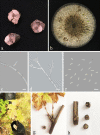Biscogniauxia rosacearum the charcoal canker agent as a pathogen associated with grapevine trunk diseases in Zagros region of Iran
- PMID: 34239007
- PMCID: PMC8266873
- DOI: 10.1038/s41598-021-93630-w
Biscogniauxia rosacearum the charcoal canker agent as a pathogen associated with grapevine trunk diseases in Zagros region of Iran
Abstract
Grapevine trunk diseases (GTDs) are well-known and significant fungal diseases of Vitis vinifera with a worldwide distribution. During August to November 2016 in a survey to characterize fungi associated with grapevine trunk diseases in Kermanshah Province (west of Iran) vineyards, 286 fungal isolates were obtained. Based on morphology and DNA sequences data eight species were identified, of which Biscogniauxia rosacearum, Neoscytalidium hyalinum and Phaeoacremonium minimum were the most aggressive fungal pathogenic species characterized in this research. N. hyalinum was the most prevalent species. N. hyalinum and Ph. minimum have previously been reported from Vitis vinifera. Thus far, there are two records of Biscogniauxia mediterranea and Biscogniauxia capnodes on grapevine in the world with no data on pathology aspects. To our knowledge, it is the first time B. rosacearum is reported from grapevine across the globe. Pathogenicity test with three strains of B. rosacearum on 2-year-old potted grapevines confirmed the pathogenicity of B. rosacearum on grapevine. The proximity of vineyards to the oak trees in Zagros forests as one of the plant hosts of Biscogniauxia spp. further highlights the need for extensive studies on B. rosacearum as a new fungal pathogen.
Conflict of interest statement
The authors declare no competing interests.
Figures



References
-
- Food and Agriculture Organization of the United Nations. FAOSTAT Database. Rome Italy: FAO. Retrieved November 20, 2020 from http://www.fao.org/faostat/en/#home (2018).
-
- Agustí-Brisach C, Armengol J. Black-foot disease of grapevine: An update on taxonomy, epidemiology and management strategies. Phytopathol. Mediterr. 2013;52:245–261.
-
- Bertsch C, et al. Grapevine trunk diseases: Complex and still poorly understood. Plant Pathol. 2013;62:243–265. doi: 10.1111/j.1365-3059.2012.02674.x. - DOI
-
- Úrbez-Torres JR, Adams P, Kamasand J, Gubler WD. Identification, incidence, and pathogenicity of fungal species associated with grapevine dieback in Texas. Am. J. Enol. Vitic. 2009;60:497–507.
Publication types
MeSH terms
Substances
Supplementary concepts
LinkOut - more resources
Full Text Sources
Miscellaneous

